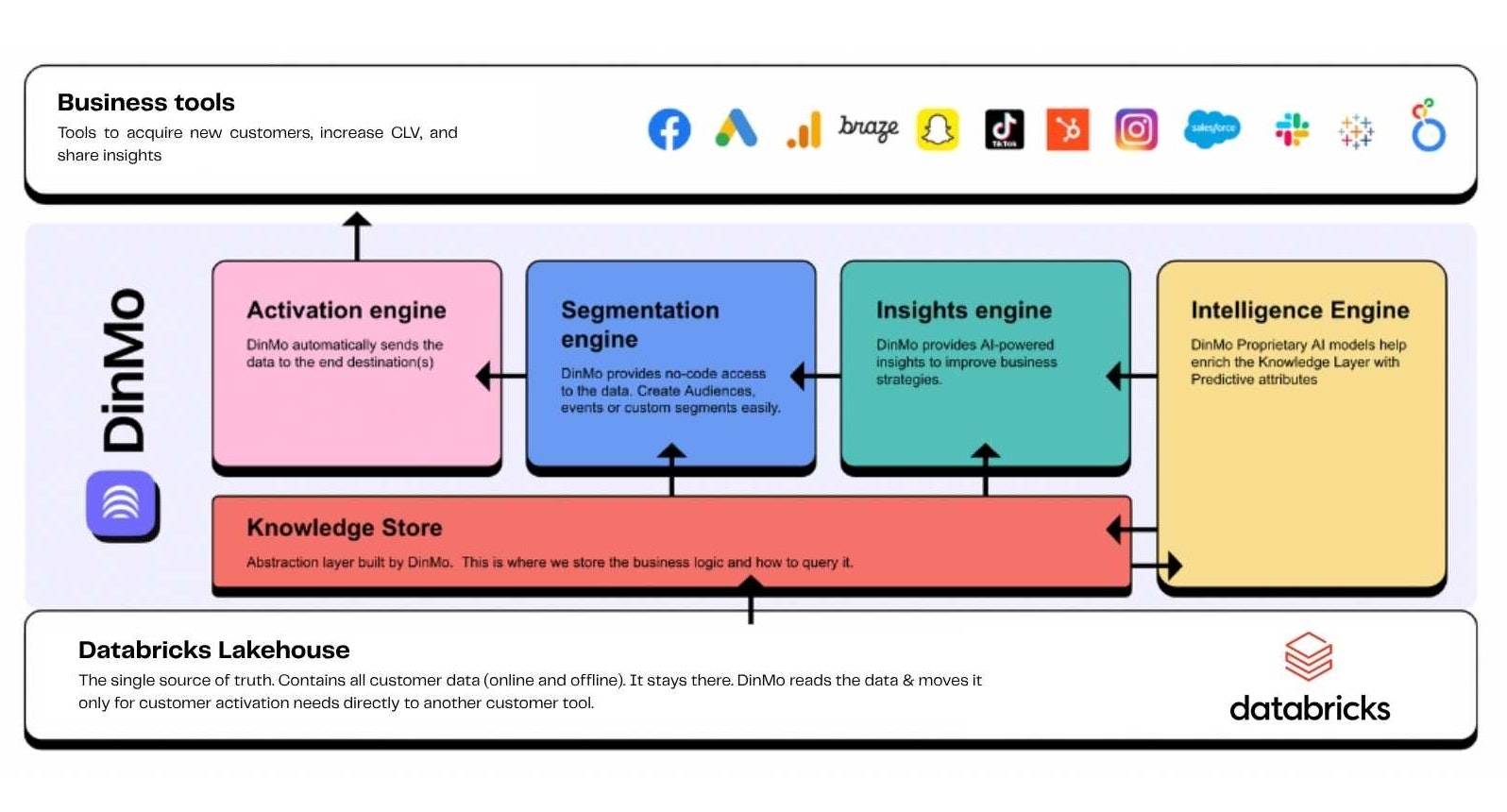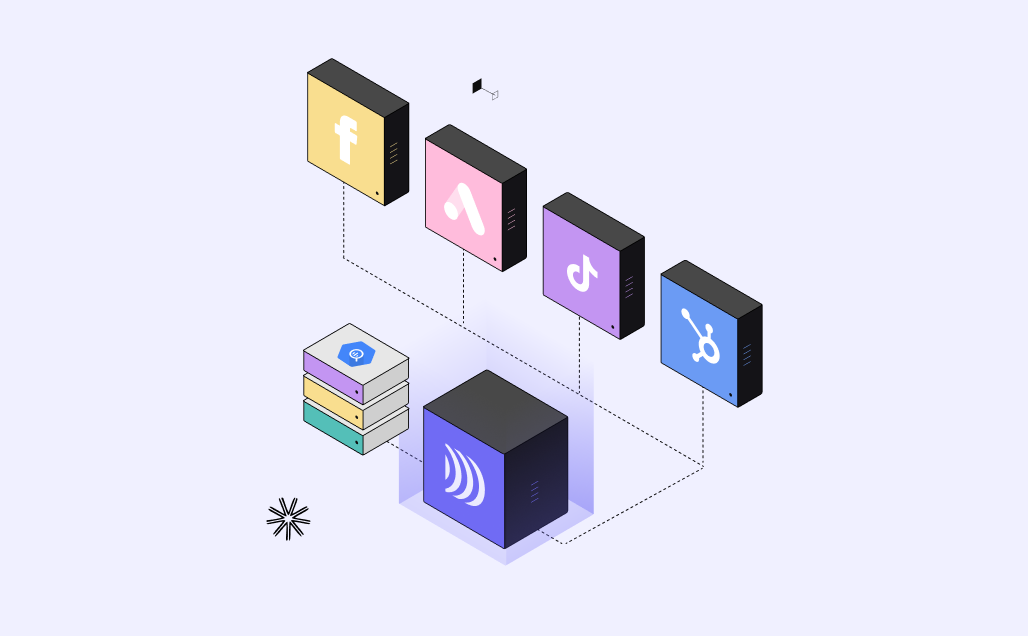
Using Databricks to implement your composable CDP
5min • Last updated on Nov 24, 2025

Olivier Renard
Content & SEO Manager
[👉 Summarise this article using ChatGPT, Google AI or Perplexity.]
The end of third-party cookies, the explosion in data volumes and the rise of omnichannel strategies are reshaping how brands leverage customer data. At the same time, the widespread adoption of cloud data warehouses is fuelling the emergence of composable architectures, more flexible and privacy-aligned by design.
Since 2013, Databricks has been one of the main drivers of this shift, alongside Snowflake, Google BigQuery, and Amazon Redshift. Yet many marketing teams still only use a fraction of their lakehouse’s potential.
A composable Customer Data Platform (CDP) connected to Databricks enables you to unify, segment, and activate your data directly from your warehouse – without technical complexity.
Key Takeaways:
Databricks is a cloud platform best known for its ‘lakehouse’ concept, combining the capabilities of a data warehouse and a data lake. It’s an ideal foundation for building a composable (or modular) CDP.
Compared to packaged CDPs, the composable approach has multiple advantages: no data duplication, more flexibility, and controlled costs.
DinMo leverages the data stored in Databricks: advanced segmentation, AI attributes, and real-time activation across all channels.
The technical architecture enables fast deployment, compliance, scalability, and strong autonomy for business teams.
🔎 How does a composable CDP work with Databricks, what are its key benefits, and which marketing use cases can you explore? Choose the right architecture and activate your data directly from your lakehouse. 🚀
What is a composable CDP?
A composable CDP is a platform that unifies, models, and activates customer data stored in a company’s data warehouse.
It uses this data without duplicating it, to provide a 360° customer view and enhance journeys.
Unlike a CRM, a Customer Data Platform handles customer data from all channels, making it directly actionable in business tools (emails, SMS, ads, apps, support, etc).
💡 If you’ve chosen Databricks, DinMo’s composable CDP lets you run these operations without changing your infrastructure.
The pillars of a composable architecture
There are four of them:
Data centralised in a cloud warehouse/lakehouse: one single source of truth for all customer data.
Scalability and interoperability: a flexible infrastructure designed to evolve and integrate easily with your existing stack.
Zero-copy: no duplication. Data stays in Databricks to guarantee reliability and compliance.
Modular approach: each component (integration, storage, activation, orchestration) evolves independently, following a “best of breed” logic.
Packaged CDP vs Composable CDP
Criteria | Packaged CDP | Composable CDP + Databricks |
|---|---|---|
Architecture | Monolithic all-in-one platform | Modular, connected to the lakehouse |
Data storage | Data copied into the CDP, extra costs | Zero-copy: data remains in Databricks |
Governance | Limited control | Control and governance within organisation’s data stack |
Time-to-value | Long deployment | Fast, use case-driven deployment |
Flexibility | Rigid data model and fixed features | Evolving stack, tailored to business needs |
Packaged CDPs come with architectural limitations: data duplication, high costs, lack of flexibility, IT dependence, and rigid data models.
In contrast, the composable model is ideal for data-driven businesses. It offers a scalable, compliant infrastructure that integrates naturally with your company’s data warehouse.
By using Databricks as the backbone of your composable CDP, you combine computing power, governance, and omnichannel activation. With DinMo, first use cases can be launched in just minutes.
Why choose Databricks as the foundation for your composable CDP?
What is Databricks?
Founded in 2013 by the creators of Apache Spark, Databricks is a cloud platform designed for analytics and AI. It is renowned for its lakehouse: a hybrid architecture combining the flexibility of a data lake with the performance of a data warehouse.
This enables businesses to store, process and analyse all their data in one place. Key advantages of Databricks include:
Processing power: fast handling of massive omnichannel data volumes.
Multi-language compatibility: works with SQL, Python, R, or Scala to suit any technical team.
Built-in AI and machine learning capabilities: advanced understanding and smarter data management.
Data governance, quality, and security: ensured by Delta Lake and Unity Catalog.
Interoperability: integrates with other data and marketing systems.
Cost control: unified architecture and pay-as-you-go pricing.
Databricks belongs to the same family as Snowflake, Google BigQuery, and Amazon Redshift, with a distinctive lakehouse architecture and AI focus.

Data Warehouse vs Data Lake vs Data Lakehouse (credit: Databricks)
Advantages of a composable CDP built on Databricks
A composable Customer Data Platform (CDP) built on Databricks benefits from a modern, scalable, and secure architecture. It offers marketing teams a powerful technical foundation without added complexity.
Databricks centralises all customer data in one environment, without duplication in the CDP’s own database. This ensures coherence, performance, and compliance. It provides a flexible framework that adapts to various use cases and business needs.
Key steps
The implementation of a composable CDP is structured around three main phases:
Data collection and integration into a single source of truth: ingest data from multiple sources (web, mobile apps, CRM, Ads, analytics, in-store, etc).
Modelling and Customer 360: unify customer profiles through identity resolution.
Omnichannel activation: sync segments and attributes to business tools via Reverse ETL.
Data governance and compliance are guaranteed: your organisation maintains full control over customer data, managed securely and in line with regulations.

Data activation with DinMo from the lakehouse
Key strengths of the Databricks x DinMo integration
With DinMo, data is activated directly from your lakehouse, with no duplication into another environment. Marketing teams can create advanced segments, compute predictive scores, and automate targeting via a simple and intuitive no-code interface.
Thanks to our Reverse ETL, customer data is synced in real time with Ads, CRM, email, or support tools. Accessible to business teams, DinMo allows you to test and deploy new use cases in minutes – delivering fast time-to-value.
Main use cases
Multichannel audience activation: create dynamic segments combining RFM, behaviours, and AI scores, then activate them in real time across Ads, email, SMS, or on-site channels.
Customer Lifetime Value (LTV) improvement: identify high-potential customers, predict churn, and automate retention actions based on centralised Databricks data.
Personalised customer experience: fuel your business tools with unified data to deliver consistent experiences across all touchpoints. Trigger the most relevant action for each customer based on context.
Improved sales performance: deliver better-qualified leads to sales teams, enriched with behavioural data from your warehouse and CDP scoring.
Customer data governance and control: ensure consistency, compliance, and traceability of all activated data across your business tools.
💡 Practical tip:
To get quick wins from the DinMo x Databricks integration, start with high-impact use cases. Activate your priority segments linked to business goals and implement continuous optimisation.
Test, measure, and iterate while closely monitoring KPIs (LTV, CAC, conversions).
Conclusion
The composable model, combined with the power of the Databricks Lakehouse, provides a robust foundation for truly data-driven marketing. Companies can unify, analyse, and activate customer data without technical complexity – while ensuring performance and compliance.
With DinMo, marketing teams gain autonomy: they create their own segments, activate audiences, and leverage predictive intelligence to optimise every customer interaction. This approach fosters responsible, scalable innovation over the long term.
👉 Book a personalised demo to discover how DinMo activates your Databricks data.





















